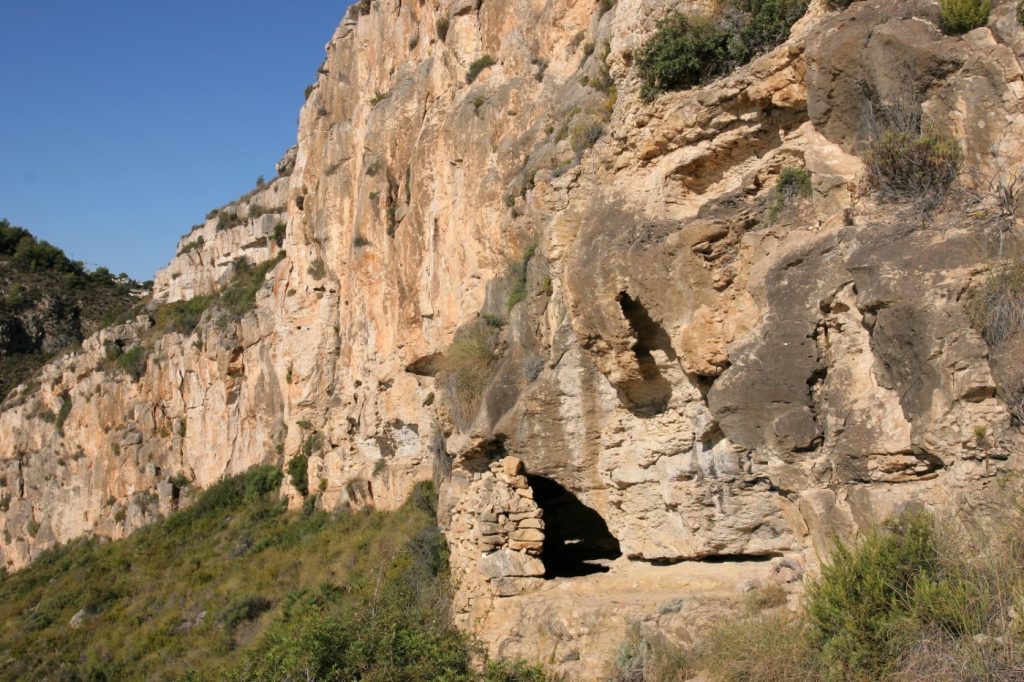On the coastal Cliff area, on the Route dels Penya-segats linking to the coves of the Moraig and the Llebeig detect some constructions of dry stone, attached to the rock wall. These buildings are from the late 19th century and early 20th. They have a very basic building, where stone wall defines the space of protection from sun and rain.
he caves used to have only one entrance with small dimensions as well as the inside was small. These original buildings were located in areas to turn a small fenced for the working animals, or to fire in their around. Occasionally users of these caves were fishermen and farmers of El Poble Nou de Benitatxell, who came to cultivate the small strips of land in this area. They also were used by smugglers waiting hidden to skiffs loaded with tobacco, fabrics, etc. The caves still retain the name of his owner.
These constructions are still preserved, almost intact and are one of the most important attractions of the Route dels Penya-segats..
Cova les Morretes
This cave is located at the base of the cliff upon the Cala Moraig, using the natural cavity which was built caused by the erosion. Built up with dry-stone and mortar, in different structures: inside housing, an oven for baking bread and a crib for animals.
Its wall of stone and mud closes the cavity on the Southeast, an opening to the North and another closing with canvas to the South. Inside there are two benches of stone and a blindly window in which some shelves inserted. Outside, in front of the entrance door, there is another bank and a fence of stone about 70 centimetres in height which delimits a rocky wall corridor about 2 meters in width.
The oven to bake bread is round flat and is situated at the end of the stone fence. Behind the cave, a space of about 1.5 meters in height, formed by the cliff, was used as a stable for animals.
Cova del «ti Domingo l'Abiar»
The cave of el ti Domingo l'Abiar in walking distance of the previous one, by continuing the path towards the South, is still used from fishermen as refuge. Three dry stone walls enclosing the cavity, formed by the rock wall of the cliff. A door as the only opening is oriented to the South. In front of the entrance, a rock closes a space and a canvas is used as protection from sun and moisture. 10 metres away, there is another construction that was used as a refuge for working animals. On a stone of the south wall is engraved the date 1937.
“Pepet del Morret” cave
The cave Pepet del Morret is located on the same cliff, further to the South, on the coast line area known as "els Pegats". The construction consists of a dry-stone wall that closes a very small space on the rock. The only opening is closed by a wooden door. The height of the cave is small in size.
Around this cave there are structures of margins of containment, some steps to access from one level to another. Next to the cave, discovered a space delimited by large rocks detached from the cliff, a fireplace and where some stones make table and chairs.
On the outside, there are large rocks detached from the wall, forming a small tunnel where you will have to go through to get to the next cave.
Cova del «ti Toni el Senyalat»
Cova Toni el Senyalat is one of the most extensive of dimensions of dry stone of 3.5 by 2 metres, which encloses a natural cavity of 8 metres wide by 3.5 meters in depth. There are no structures inside and the opening is closed by a wooden door. The floor of the cave presents different levels of enabled stone margins.
Cova del Morro del Bou
This cave is located on the base of the nose of Morro del Bou, within walking distance of Cala Llebeig. Built with dry-stone encloses a natural cavity, leaving an opening to enter. In front of the cave is a space to make fire, protected by the rocky wall. The cave is still used occasionally by some fishermen.
